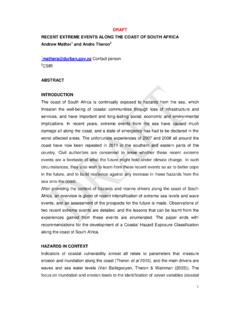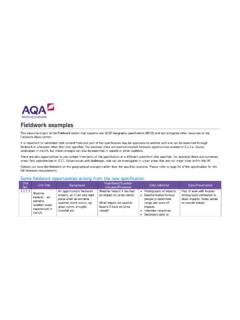Transcription of GREATER KNYSNA MUNICIPAL
1 GREATER KNYSNA MUNICIPAL DISASTER RISK MANAGEMENT PLAN TABLE OF CONTENTS No Contents Page 1 MUNICIPAL Logo 2 Table of contents 3 Foreword 4 Purpose of the Plan 5 Background a) Introduction b) Objectives c) Types of Disasters d) Response to a major disaster e) Communications f) Counselling Services g) Insurance Liability h) Financial Implication i) Debriefing j) Closure of incident k) Abbreviations l) Definitions/Glossary of terms 6 Constitutional Legislative mandates 7 Institutional arrangement 8 Hazard/Vulnerabilities Assessment (Risk Profile) 9 New severe weather alert levels 10 Primary & Secondary responsibilities 11 ICT Disaster Recovery Action Plan 12 Disaster Response Plan process flow and incident command structure 13 KNYSNA MUNICIPAL Disaster Management Plan for Sedgefield 14 Declaration Authorization and approval of the Disaster Risk Management Plan 3.
2 FOREWORD Disaster Management is everybody s business We live in a fast changing global environment where peril and risk to human society abound. Disaster has the ability to maim and kill people. They destroy property and the environment. Yet, disasters occur and re-occur with lasting detrimental consequences. The enormity of the disaster problem today and in the foreseeable future calls for a more proactive approach that ensure effective disaster reduction at all levels towards sustainable development. Though one must always remember that it is not always possible to completely eliminate a risk, extensive experience and practise in the past have demonstrated that the damage caused by any disaster can be minimized largely by careful planning, mitigation and prompt action.
3 We would like to further invite relevant stakeholders to join in contributing to Disaster Risk reduction. Disaster Risk Management is and will always be everybody s business. 4. PURPOSE OF THE PLAN The purpose of the disaster risk management plan is to enhance the capacity of the Municipality to prevent and to deal with disaster and to avoid developments which are subject to high risk of disaster. The Disaster Management Plan is to be seen as an information guide to the relevant role players. It shall advise the role players how to lead in case of a disaster to prevent or at least mitigate negative effects on the GREATER KNYSNA .
4 The plan will be the basis to establish procedures which will assure maximum and efficiently utilization of all resources in and around the GREATER KNYSNA , minimize the loss of life and/or injury. With a comprehensive DMP (Disaster Management Plan), GREATER KNYSNA Municipality will be better prepared to support the local communities in dealing with disasters and to speed up the recovery process. It is crucial to have effective and efficient Disaster Risk Management in order to save lives, prevent escalation of emergencies and incidents and relieve suffering.
5 5. BACKGROUND The Garden Route has a Mediterranean maritime climate with moderately hot summers, and mild to chilly winters This plan serves to confirm the arrangements within the GREATER KNYSNA Municipality to effectively prevent disaster from occurring and to lessen the impact of these hazards that cannot be avoided. Disaster Management is a continuous and integrated multi-sectoral and multi-disciplinary process of planning and implementation of measures aimed at Disaster prevention mitigation, preparedness, response, recovery and rehabilitation (Disaster Management Act 2007) Province: Western Cape District: Eden Type: Local Municipality MUNICIPAL Code: WC048 Main town: KNYSNA Languages: Afrikaans, English & Xhosa Area: 1059km2 Population.
6 65043 The population is diversified across race, groups and culture and are characterised by varying levels of socio-economic status and education. INTRODUCTION In accordance with the Act and with the desire to better provide for the wellbeing of its citizens, the KNYSNA Municipality is developing a Disaster Management Plan to ensure preparedness and effective response by the Municipality and its citizens in the event of a disaster. What is a disaster? A disaster is a progressive and sudden, widespread or localized, nature or man-made occurrence which causes: a) (i) death, inquiry or sickness (ii) damage to property, infrastructure or the environment, or (iii) disruption of a community, and b) if of a magnitude which exceeds the ability of those who are affected to defend the results by making use of only their own resources.
7 What is disaster management? Disaster management is a continuous and integrated multi sector, multi disciplinary process of planning and implementation of measures aimed at- a) prevention or reduction of the risk of disaster; b) relieve of the severity of results of disasters; c) emergency preparedness; d) swift and effective reaction on disasters; and e) after-disaster repair and rehabilitation. OBJECTIVES The objectives of the plan are as follows: * To regulate the disaster response to the benefit of the community and visitors.
8 * To respond effectively to the requirements of individuals towards the protection of life and property. * To establish those most vulnerable and at risk. * To provide temporary sheltered accommodation, clothing and feeding arrangements for persons evacuated, or made temporarily homeless. * To restore normality o the affected community within a reasonable timescale, dependent on the seriousness of the incident. TYPES OF DISASTERS It often happens that disasters do not occur in isolation and that one disaster occurs as a result of another.
9 Therefore it is important to be aware of all possible disasters that may affect your region. DISASTER CATEGORIES Broad Hazard Category Specific Disaster Risk Category Hydrometeorological Climate-Related Extreme weather Meteorological drought Hydrological Riverine flooding Estuarine flooding Coastal flooding/storm surges Urban flooding Hydrological drought Agricultural drought Geological Seismic risks and earthquakes Rock falls and landslides Biological Fires Urban fringe fires, Veld fires Epidemics Humans, Livestock Environmental Air pollution Water pollution Soil erosion/land degradation Technological risks associated with installations Power plants Bridges, Dams Petrochemical installations risks associated with transport Roads Air, Sea Rail Hazmat Marine oil spills Toxic cargo spills Radioactivity emissions risks associated with flammable surfaces Urban format fire Urban informal fire RESPONSE TO A MAJOR DISASTER a)
10 Activating Procedure * The Disaster Control Official, after having received an early warning from the Eden Disaster Risk management of a possible incident, will contact the MUNICIPAL Manager / Disaster Management by telephone, and if he is not available, the Acting MUNICIPAL Manager. * Disaster Control Official will in turn contact the Duty Officer at the Control Room and advise them of the danger. * The Control Room Official will be instructed to contact all the relevant role players requesting them to place their personnel on stand by.











